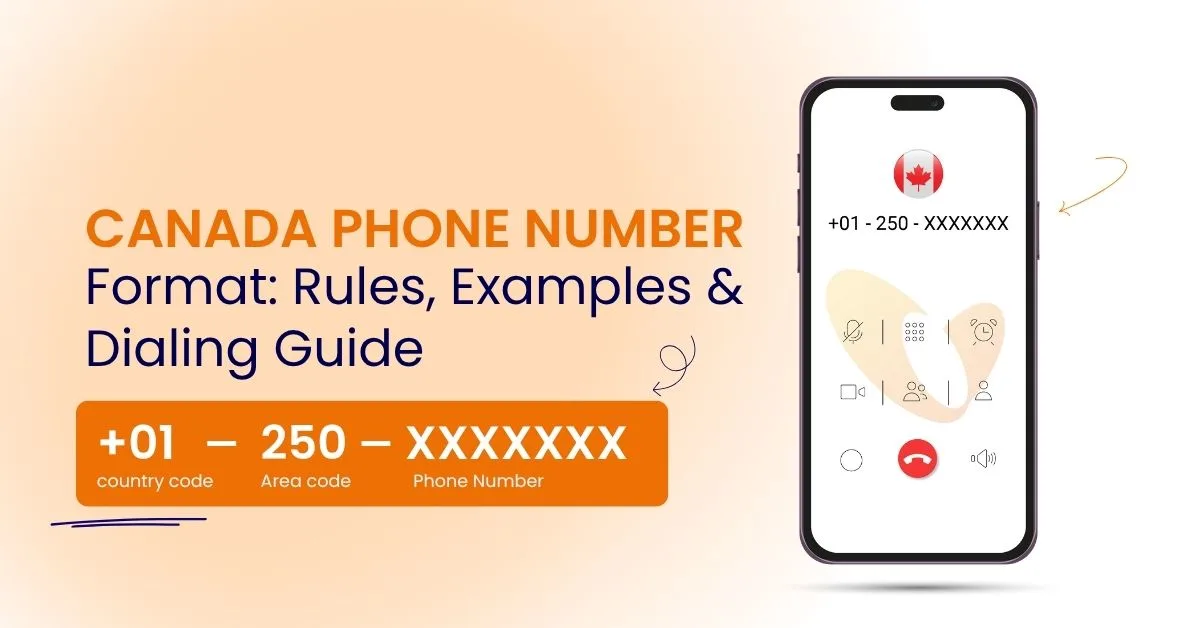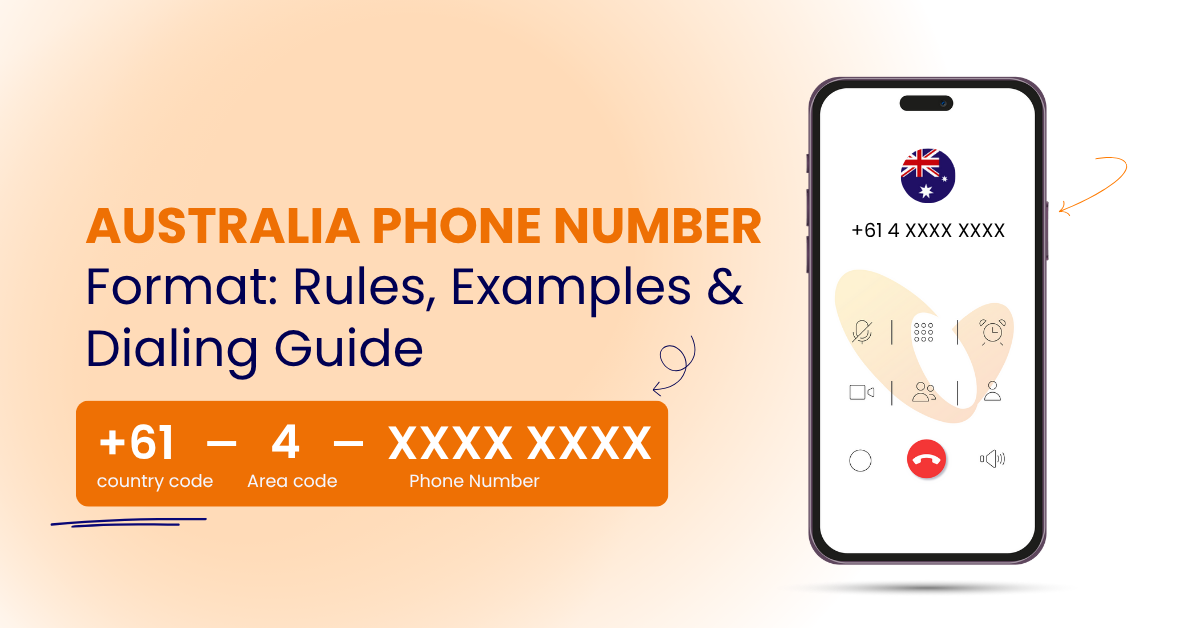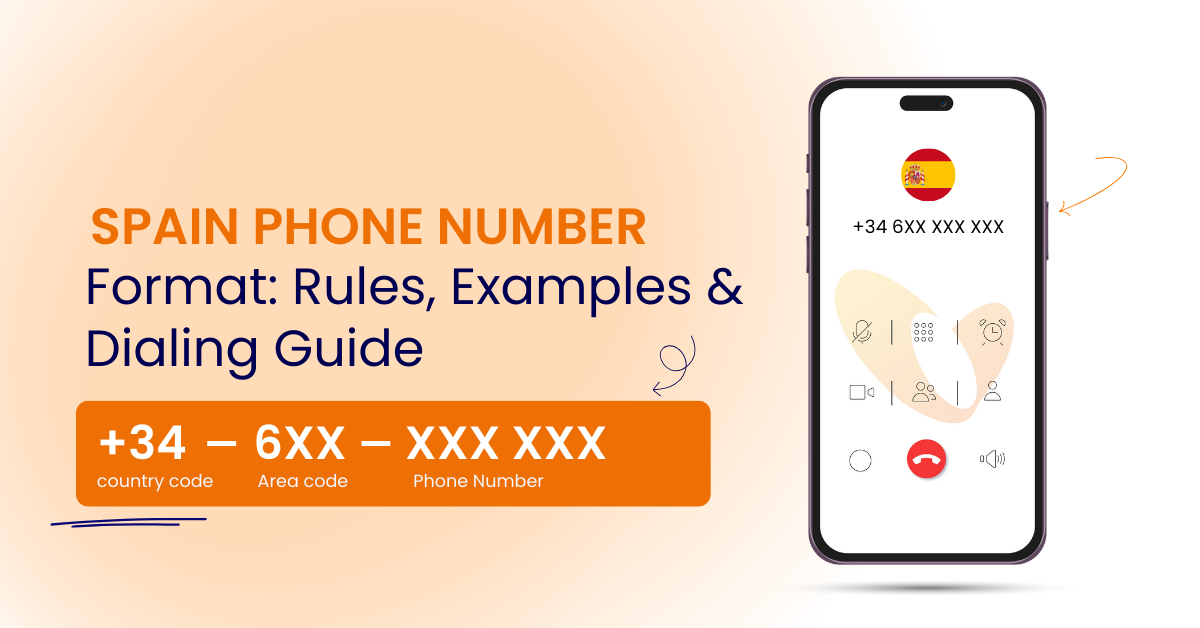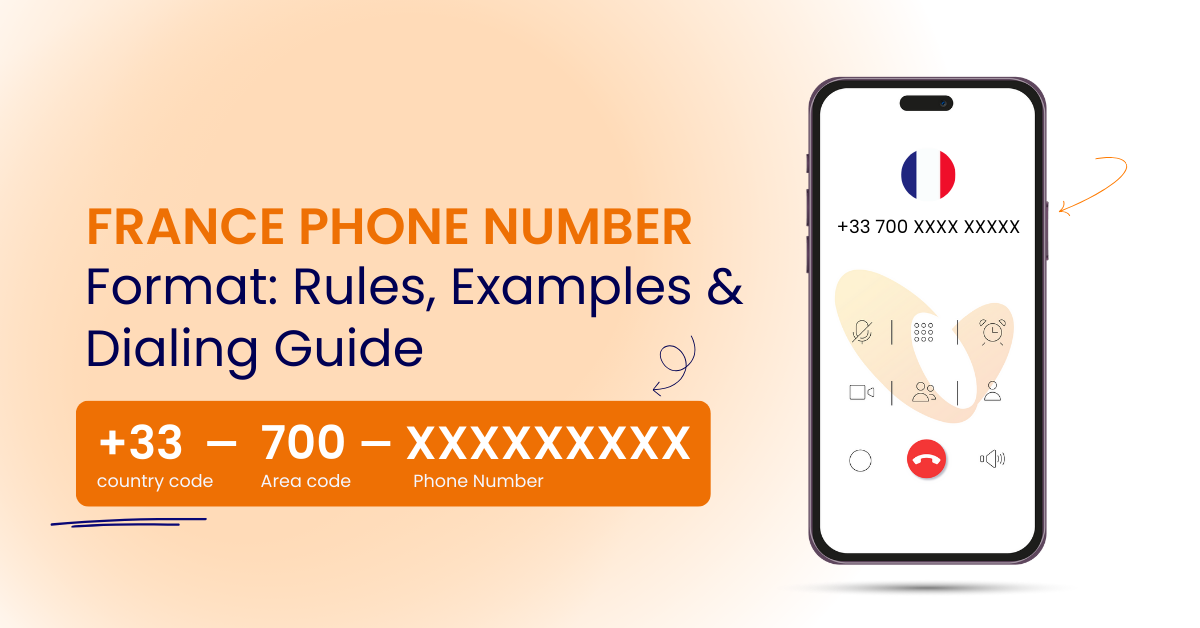Canada Phone Number Format Made Simple

6 min read
Table of Contents
Need to understand the Canadian phone number format? This easy guide explains how to dial Canadian numbers correctly for national and international calls—whether you’re connecting within Canada or from overseas.
Using the right format ensures smooth communication, especially for businesses using cloud-based phone systems, VoIP services, or virtual phone systems like Vitel Global.
Proper phone number formatting isn’t just a technical detail—it’s what keeps your communication consistent, professional, and reliable. Using the correct format, especially with a local phone number, helps businesses build trust and credibility with local customers and establish a local presence.
Key Takeaways
- Canada numbers follow this format: +1 (country code) – area code – local number (7 digits)
- Use spaces or hyphens for clarity (avoid brackets in VoIP systems).
- Always include the +1 prefix when dialing internationally or storing numbers in cloud systems.
- Correct formatting helps avoid dropped calls and misrouted connections in VoIP and CRM platforms.
- Watch out for common mistakes in formatting and dialing to avoid failed connections.
Country Code: +1
Canada follows the North American Numbering Plan (NANP)—the same system used by the United States and many Caribbean countries.
All Canadian numbers start with +1, which is Canada’s country code, when dialed from abroad.
When dialing a Canadian number from another country, you must first enter your country’s exit code (also known as the international access code), then Canada’s country code (+1), followed by the area code and local number.
Example:
+1 416 555 xxxx (Toronto, Ontario) Instead of 416 555 xxxx when calling locally.
Area Codes
| Province/Territory | Common Area Codes | Major Cities/Regions |
| Ontario | 416, 905, 613, 807 | Toronto, Ottawa, Hamilton |
| British Columbia | 604, 250, 778 | Vancouver, Victoria |
| Quebec | 514, 438, 819 | Montreal, Quebec City |
| Alberta | 403, 587, 780 | Calgary, Edmonton |
| Nova Scotia & PEI | 902,782 | Halifax, Charlottetown |
| Manitoba | 204,431 | Winnipeg |
| Saskatchewan | 306,639 | Regina, Saskatoon |
| New Brunswick | 506 | Moncton, Fredericton |
| Newfoundland & Labrador | 709 | St. John’s |
Some Canadian provinces have multiple area codes to serve growing populations and expanding regions. Using the correct area code is essential for accurate dialing and effective business communications.
Local Number
After the area code, the local subscriber number is a seven-digit subscriber number—split as a 3-digit exchange code (also known as the central office code) and a 4-digit line number. The standard format for the local number is written as xxx xxxx.
Example:
(416) 555-xxxx → Area code (416) + Exchange/Central Office Code (555) + Line (xxxx)
Mobile Numbers in Canada
Unlike in some countries, mobile numbers in Canada follow the same format as landlines—there’s no special prefix. A mobile number is assigned to a mobile phone and operates on cellular networks, making it portable and not tied to a specific location such as a fixed landline. This means a Canadian mobile number can be used across different regions, like Toronto or British Columbia, without being restricted to a specific area code.
A Canadian mobile number can be easily obtained or ported through VoIP services, making it a flexible option for both personal and business communication.
However, most mobile networks are assigned newer area codes like 647 (Toronto) or 438 (Montreal).
Examples:
- National format: (647) 555-xxxx
- International format: +1 647 555 xxxx
VoIP platforms and business phone systems such as Vitel Global’s VoIP Solutions can automatically convert local formats to international standards (E.164) for global compatibility.
How to Dial Canada Phone Numbers
To make sure your calls connect smoothly, use the correct dialing pattern based on your location.
When dialing within Canada, enter the trunk prefix (1) and then the area code, followed by the local number.
When making international calls to Canada, always start with your country’s exit code, then the area code, and the local number.
For Domestic Calls (Within Canada)
Dial the 10-digit number directly: Area Code + Local Number
For local calls, you may only need to dial the local number in some regions, but 10-digit dialing is now standard in most areas.
Using local numbers helps businesses connect more easily with customers in their area, fostering trust and improving communication with regional clients.
Example: 416 555 xxxx
If you’re calling long-distance (e.g., Toronto to Vancouver), add 1 before the area code: 1 604 555 xxxx
For International Calls to Canada
When calling Canada from another country, use this format: Your country’s exit code + 1 + 10-digit Canadian number
Example (from the UK): 00 1 416 555 xxxx
Example (from India): 011 1 604 555 xxxx
Using the correct format when dialing Canadian numbers is essential to avoid connection issues and ensure your call goes through successfully.
Formatting Canada Phone Numbers
Correctly formatted numbers prevent failed calls, missed messages, and CRM sync errors. Proper formatting also ensures that customers can answer calls without confusion or missed connections.
National Format
Use spaces or hyphens for clarity. The local number is typically written as xxx xxxx for standardization.
Example: 416 555 xxxx or 416-555-xxxx
International Format
Use the +1 prefix, followed by spaces between number groups. Example: +1 416 555 xxxx
Avoid parentheses or slashes when storing numbers in VoIP databases or CRMs to maintain global consistency. Storing numbers in international format is especially important when using a Canadian virtual phone number for business or remote work, as it ensures seamless connectivity and compatibility across global communication platforms.
Types of Canadian Phone Numbers
Canadian telephone numbers are classified into geographic, non-geographic, and toll-free numbers.
Geographic Numbers
- Begin with local area codes like 416 or 604.
- Used for landlines and regional presence.
- Ideal for companies wanting to appear local in specific cities. A local Canadian phone number or local Canadian number helps businesses establish a strong presence in their target city or region, building trust and credibility with local customers.
Example:
Toronto business: +1 416 555 xxxx
Vancouver business: +1 604 555 xxxx (a Vancouver number, which is a type of local phone number for businesses in British Columbia)
Non-Geographic Numbers
- Used nationwide without being tied to a specific city.
- These are toll free numbers, starting with prefixes like 800, 833, 844, 855, 866, 877, or 888. Incoming calls to a toll free number are routed to the business at no cost to the caller.
- Perfect for customer service or nationwide support lines. Businesses can also use vanity numbers—customized toll free numbers that are easy to remember and help enhance brand recognition.
Example:
+1 800 555 1234 (Toll-free customer service line)
Special Service Numbers
- Used for emergencies or helplines.
- 911: Emergency (Police, Fire, Ambulance)
- 611: Phone service provider support
- 411: Directory assistance
Validating Phone Numbers
Ensuring you have a valid Canadian phone number is essential for reliable communication—whether you’re reaching out to customers, partners, or team members. Because Canada follows the North American Numbering Plan (NANP), every Canadian phone number must adhere to a specific structure: the country code (+1), a three-digit area code, and a seven-digit local number.
When validating Canada phone numbers, always double check that the number begins with the correct country code (+1), followed by a valid three-digit area code assigned to a Canadian province or territory. The remaining seven digits should form a local number, split into a three-digit exchange code and a four-digit line number. This format ensures that your calls connect smoothly, whether you’re using a traditional phone system, a VoIP service provider, or a cloud-based business phone platform.
For businesses managing large contact lists or integrating with CRM and unified communications tools, automated validation tools can help confirm that each Canadian phone number matches the NANP standard. This reduces the risk of failed connections, misrouted calls, or data sync issues—keeping your communication channels clear and professional.
By consistently validating Canadian phone numbers, you’ll maintain accurate records, improve customer experience, and ensure your business communications run without a hitch.
Common Issues and Solutions
| Issue | Cause | Solution |
| Missing country code | Forgetting +1 when dialing internationally | Always include +1 for cross-border calls |
| Wrong area code | Area code mismatch | Verify the city/province before dialing |
| Invalid number length | Fewer or extra digits | Canadian numbers are always 10 digits (excluding +1) |
| CRM sync errors | Symbols or parentheses | Use E.164 format (+1416555xxxx) for VoIP systems |
| Unexpected local charges | Calling certain geographic or shared-cost numbers | Check if local charges apply before dialing. |
| Calls from unknown numbers | Using non-local or international numbers | Use a local Canadian number to increase answer rates. |
Examples of Canadian Phone Numbers
| Type | National Format | International Format |
| Landline | 416 555 xxxx This is a Canadian landline number, used for traditional telephone services. | +1 416 555 xxxx |
| Mobile | 647 555 xxxx The local part is a seven digit subscriber number. | +1 647 555 xxxx |
| Toll-Free | 800 555 xxxx | +1 800 555 xxxx |
VoIP and Canada Phone Numbers
If your business uses VoIP or cloud telephony, getting the Canada phone number format right is critical. Virtual phone numbers, including a virtual Canadian phone number, allow businesses to manage calls from anywhere and provide flexible telephone services. Incorrectly stored numbers can cause CRM mismatches or routing issues.
Benefits of VoIP for Canadian Businesses
- Cost-effective international calling.
- Local and toll-free numbers for every province.
- Advanced features: call forwarding, recording, and analytics.
- Easily manage receiving calls and voicemails from any device.
- Configure business hours to route calls appropriately and avoid missed opportunities.
- Perfect for remote teams across regions.
Companies using Vitel Global’s Business Phone System gain seamless communication between offices in Toronto, Calgary, and even across the U.S.
Best Practices for Calling Canadian Numbers
- Always start with +1 for international dialing.
- Use spaces or hyphens for readability.
- Double-check area codes before saving contacts.
- For VoIP systems, store numbers in E.164 format (+1XXXXXXXXXX).
- Regularly audit your CRM data for duplicates or invalid formats.
- Use local numbers to build trust and improve response rates with Canadian customers. Local numbers help establish a local presence, foster credibility, and make it easier for Canadian customers to connect with your business.
Summary
Understanding the Canada phone number format is essential for smooth communication—whether you’re calling within Canada or connecting from overseas. The format is simple: +1 (area code) + 7-digit number—but accuracy matters.
Businesses using VoIP or virtual phone systems rely on this consistency for proper routing, caller ID, and CRM syncing.
That’s where Vitel Global helps. With scalable, cloud-based VoIP solutions and intelligent number formatting, your business stays connected, clear, and compliant—across every province and beyond.
Vitel Global makes Canadian and global communication easy for teams of all sizes.
Connect Seamlessly Across Canada — Get Your Virtual Number with Vitel Global
Frequently Asked Questions (FAQs)
1. Does +1 replace the 0 in Canadian numbers?
Yes. The +1 country code replaces the initial “1” when dialing internationally. Always use +1 for cross-border or VoIP calls.
2. Do all Canadian phone numbers have 10 digits?
Yes. If you’re wondering how many digits are in a Canadian phone number, the answer is 10 digits after the +1 prefix — a 3-digit area code and a 7-digit local number.
3. How do I write a Canadian number in international format?
Start with +1, followed by the 10-digit number:
+1 604 555 xxxx (for Vancouver).
4. What are toll-free numbers in Canada?
Toll-free numbers begin with 800, 888, 877, 866, 855, or 844 and are free to call nationwide.
5. How does VoIP help with Canadian phone calls?
VoIP systems standardize formats, reduce costs, and enable multi-region routing. Providers like Vitel Global offer integrated VoIP solutions for Canadian businesses.
Published: November 5th, 2025
Subscribe to Our Latest Updates
Get monthly product and feature updates, the latest industry news, and more!





